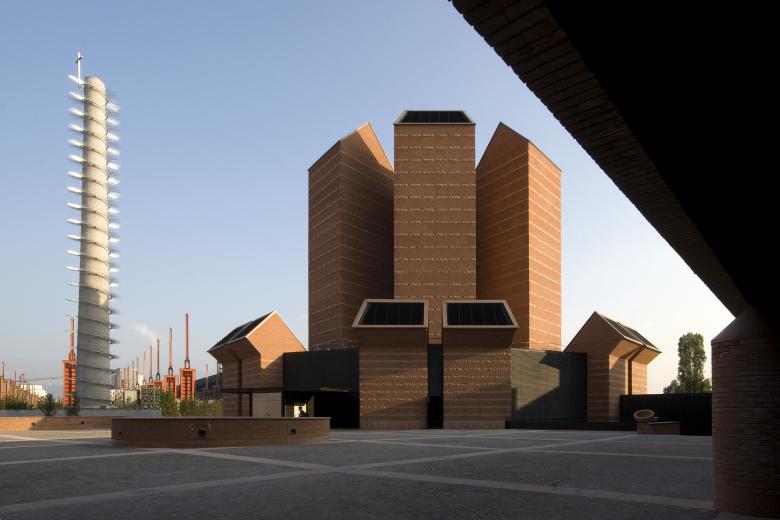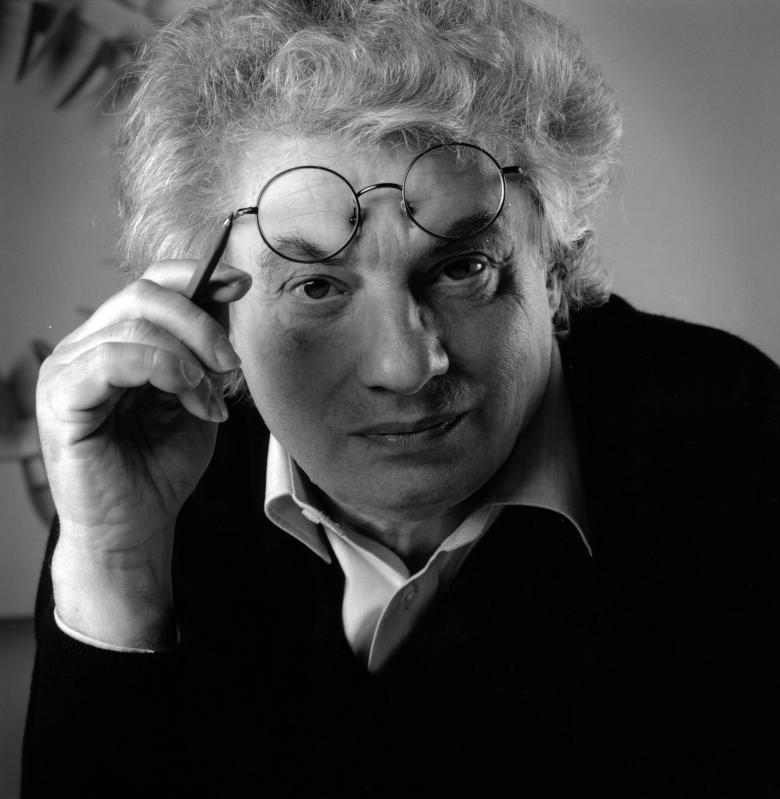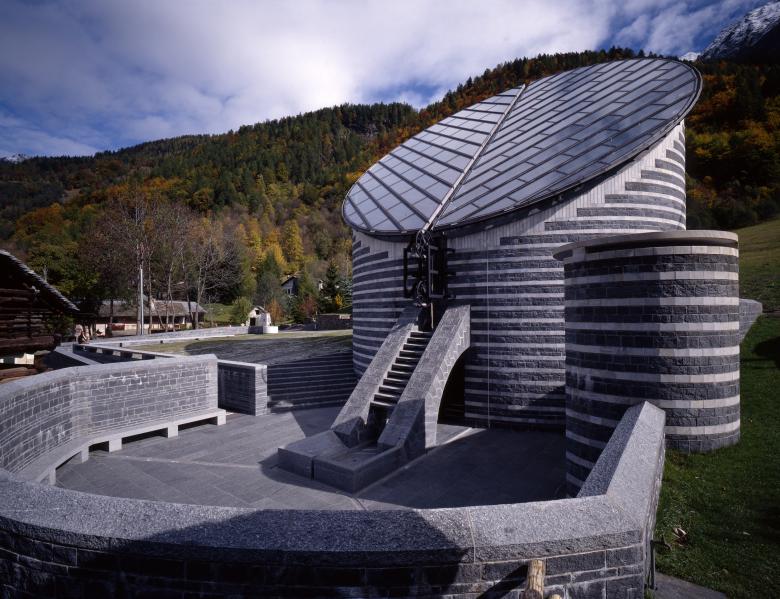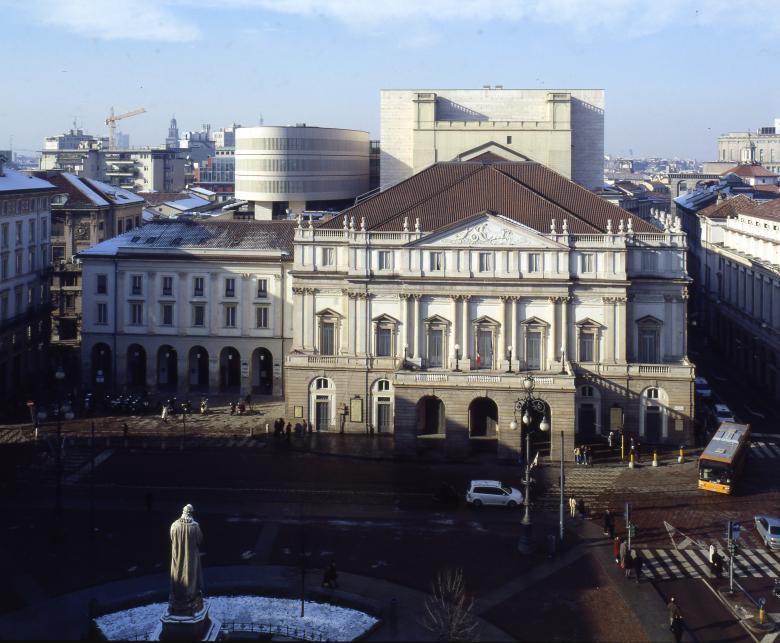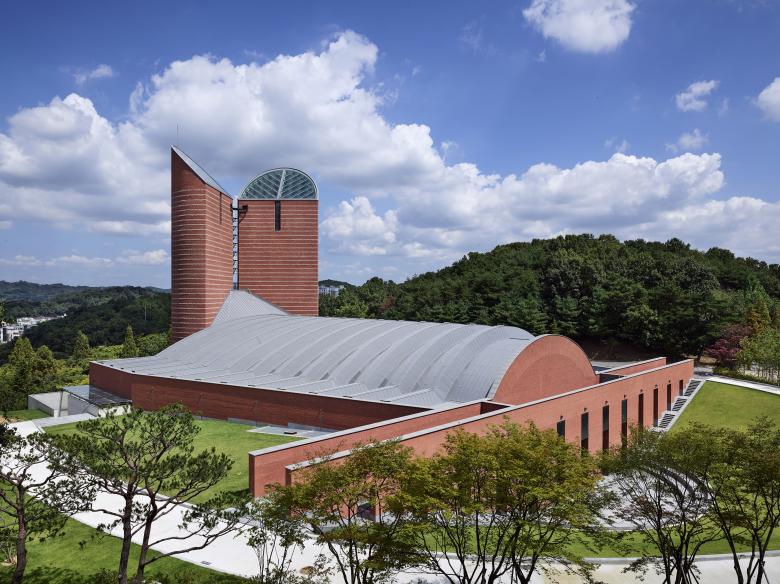16. aprile 2023
Church Santo Volto, Turin, 2001–2006 (Photo: Enrico Cano)
At 80 years old, more active than ever, Mario Botta multiplies projects across the world. For this Ticino native, the role of architecture is to go beyond function and to conjure up the sacred. Let’s meet the architect.
“We cannot build without leaning on the sacred. It has nothing to do with theology; it’s a question of attitude.”
On this Tuesday, March 21, the auditorium at ECAL (Ecole cantonale d’art de Lausanne) is packed; students, friends and architects have come in great numbers to hear Mario Botta speak. Bringing together people of all generations, the Ticino native born in 1943 in Mendrisio gave a public lecture on the relationship between architecture and design in his work. A student of Carlo Scarpa — whom he met during his studies at IUAV (University Institute for Architecture in Venice) — Botta is still very active at 80 years of age. This workaholic does not want to hear about retiring and wishes to continue until he is 100: “I have always worked relentlessly; my work is my passion. When I am under the weather, I go to my office, and everything goes back to normal!”
Mario Botta (Photo: Beat Pfändler)
In Switzerland, the strict brutalism of the Centre Dürrenmatt in Neuchâtel, the Museum Jean Tinguely in Basel, the Fiore di Pietra restaurant on Monte Generoso in Ticino, the Church of San Giovanni Battista in Mogno — his first church, magnificent, built of locally quarried stone and striped marble from Valle Maggia, still in Ticino — is easily recognizable. In 1996, with the goal to pass on his knowledge and instill passion for the profession, he founded the Accademia di Architettura di Mendrisio, a campus for which he drew the Teatro dell’Architettura (2018), a 27m-diameter cylinder inspired by the anatomical theaters used for dissections in Italy as early as the 16th century.
Church of San Giovanni Battista, Mogno, 1986–1996 (Photo: Enrico Cano)
Another great project is the restoration (2001–2004) and extension (2019–2023) of La Scala in Milan. Theatrical production has nowadays other needs than in the past, and today’s performances must follow one another rapidly. It is said that the best theaters are not those that have the best halls but rather the best stages. For the extension of the famous building inaugurated in 1778, Mario Botta had to argue long and hard with heritage advocates to garner support for his project: a tower flanked by a large elliptical volume. This contemporary addition, whose architectural tone contrasts yet also engages in a harmonious dialogue with the style of the existing building, made it possible to extend the stage and to give more space to the artists so that several performances could be rehearsed simultaneously.
Teatro alla Scala, Milan, renovation 2001–2004, extension 2019–2023 (Photo: Enrico Cano)
Also very active in China, Mario Botta has been working with unflagging energy on a major project in Shenyang, north of Beijing, for the past ten years. For this Academy of Fine Arts founded by Mao Zedong, he first drew the master plan then designed various buildings: “It’s an extraordinary opportunity that allows me to build children’s housing units, teachers’ housing units, a museum — in short, a whole campus.”
Though he embraces all architectural typologies — houses, schools, banks, offices, libraries, museums and churches — and works at a frenetic pace, Mario Botta expresses a clear preference for churches. “If I could, I would only work on sacral projects. There is still a lot to explore in this area.” In fact, he is about to complete the construction of a great basilica in Seoul and has praise for an important number of religious architectures.
For Mario Botta, “Architecture is the most sacred work there is in the built environment because it transforms a condition of nature into a condition of culture; it expresses the need for the human being to go beyond the finite, beyond the functional. We cannot build without leaning on the sacred. It has nothing to do with theology; it’s a question of attitude. Talking about the sacred constitutes a form of resistance to the leveling down we are subjected to nowadays. Consumer society and globally turned corporations have established a sort of conformity; from North to South, at the Poles or in the desert, all architectural languages are very similar today, and the same building processes are used in order to build quickly and economically. Keeping it simple is today’s mindset and there is no deep reflection. I am a postwar baby, and when I started working in the early 1960s, for architects of my generation, industrialization was supposed to improve the quality of life. The Modern Movement was based on this utopia, but everything finally grew into speculation and business. Our work has become very difficult because of the speed requested in the proposals that we must submit, despite the growing complexity of the built environment. These two opposing elements have blocked all spiritual and intellectual reflection.”
The Shrine of Our Lady of the Rosary of Namyang, Seoul, 2011–2023 (Photo: Kim Yongkwan)
Architecture and Design“I am not a designer, I am an architect who designs small architectures,” announces Botta, who, as early as 1982, also invested himself in design practice, creating chairs for Alias, then numerous chair seats, tables and other furnishings, as well as watches, a beautiful faceted vase for Lalique and stools in natural wood for Riva 1920. His most recent design project is a collection of pans for the Italian manufacturer TVS: “I agreed to take part in this project because I never designed cookware; it’s a new adventure. We’ve been working on it for three years now, in particular to make the handles which are rather complex.” The product resulting from this project will soon be available in Migros stores!
